A Post-Council Assessment of the Neon Line Proposal: Branding a District
Thoughts on the initial pitch from Jacobs Entertainment
My previous piece previewed City Council’s April 14th discussion of a proposed Development Agreement with Jacobs Entertainment that would create a new “Neon Line District” in downtown Reno, and I encourage you read it first for some background on Development Agreements and the overall parameters of this proposal.
There was a little coverage afterward from This is Reno, the Reno Gazette-Journal, and Channel 4, but I’d like to share some thoughts on what I saw in that meeting, what I didn’t see, and what I hope to see in future discussions. You can watch the entire 2-1/2 hour-long discussion here (click on D.2) and view the full proposal & staff report here.
Prior to the meeting, I was under the impression that the proposal had been drafted jointly by City staff and Jacobs Entertainment; instead, what was presented was written entirely by Jacobs, whose representative, Garrett Gordon, delivered a 36-minute, 63-slide presentation about it. City staff provided about a 10-minute introduction and then answered questions afterwards.
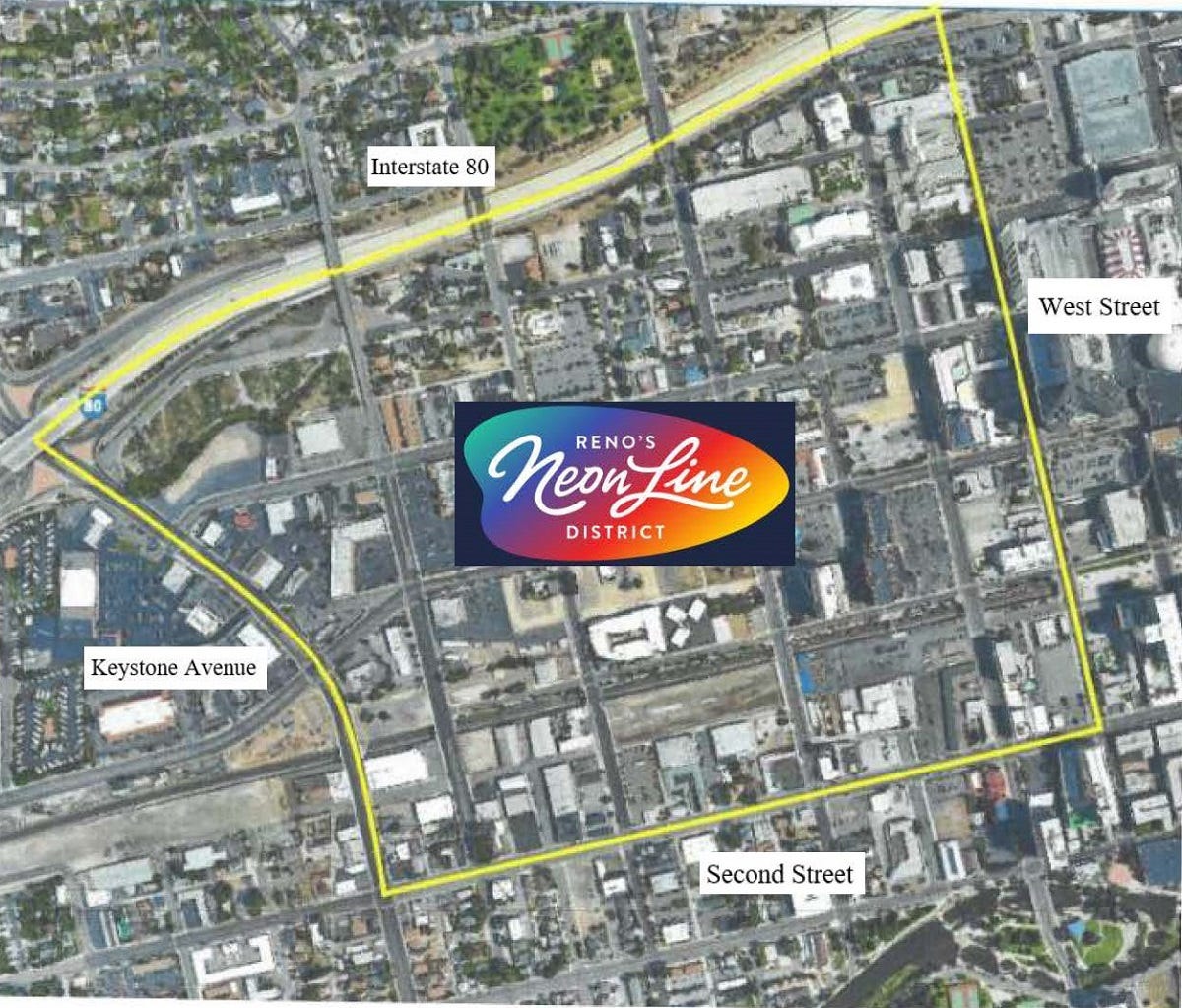
As I wrote before, a Development Agreement is a very big deal, as a binding contract that is intended to provide benefits and guarantees to both the City and the developer. The City recently loosened the requirements for what kinds of projects can qualify, and this is the first one to come over the transom.
The Jacobs proposal is a particularly complex one to start with because the company is proposing not just terms that pertain to its own properties and adjacent public rights-of-way (as one might expect) but also the use of Tax Increment Financing (explained on the City website here) involving other properties; subsidies, discounts, and fee deferrals; and some major streetscape alterations. It’s a lot to bundle into a contract with a single company, especially a contract intended to endure for 20 years or more.
Now keep in mind that this was the very first conversation with Council about this proposal—in public, anyway—and nothing was promised or accepted. Consider it Jacobs’ opening bid. So I think what’s most critical at this point, for the City Council, City staff, and Reno residents—is to take a step back and examine the big picture, weighing both the pros and cons of the major “asks” in order to determine whether the City should entertain any or all of them before moving forward to talk specifics.
Today I want to focus on the most visible component: designating and branding a new district. There is, of course, much more to assess regarding the use of Tax Increment Financing (TIF) and the critical question of community benefit.
Why Brand the Northwest Quadrant the “Neon Line District”?
The Jacobs proposal would create the “Neon Line District,” a branded area that would encompass much more than the company’s own properties, and extend from either West 2nd Street (according to their presentation’s map) or West 3rd Street (according to the written draft) on the south end to I-80 on the north, and west to east from Keystone Avenue to West Street. This is roughly the same area identified in the Reno Master Plan and Downtown Action Plan as the Northwest Quadrant (see below).
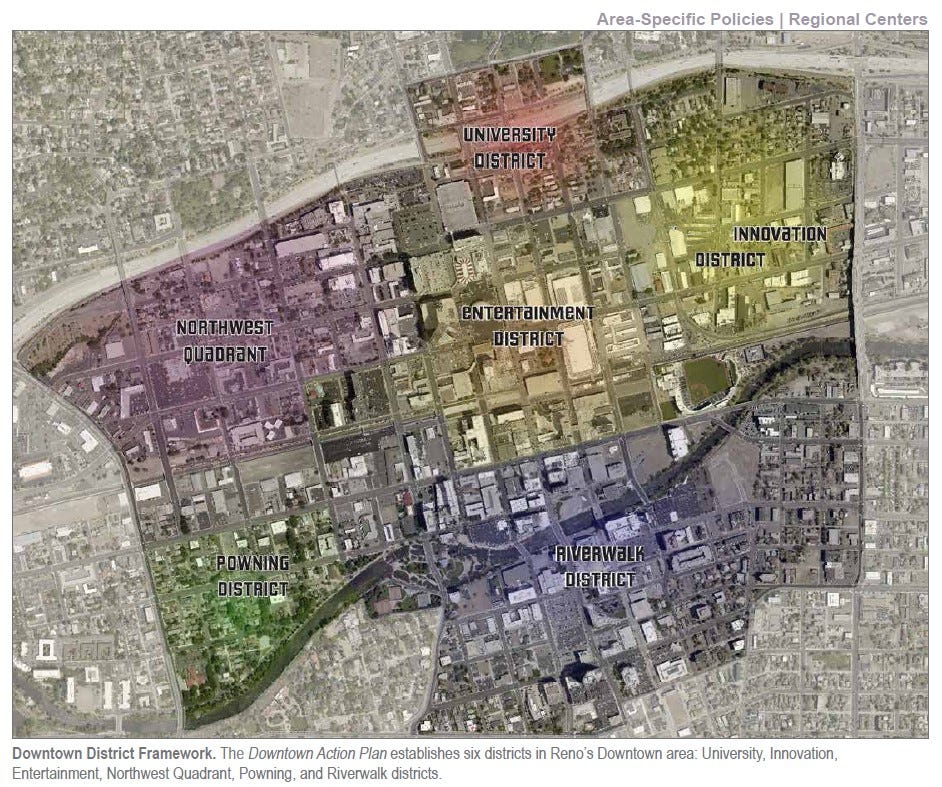
According to Jacobs, the company currently owns or controls (through purchase options, I assume) 72 individual parcels of various sizes between West 2nd Street and West 5th Street, more or less bracketed by the two casino properties they own, the Gold Dust West and the Sands Regency.
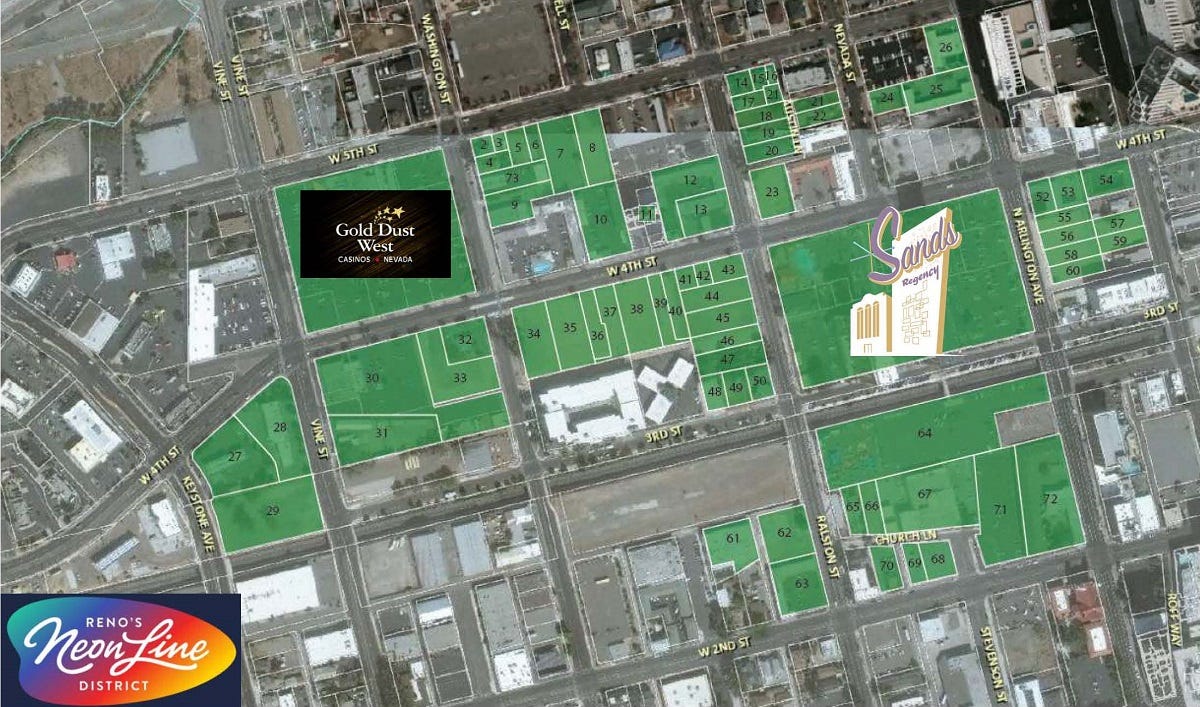
The obvious focal point of this proposed district would be the “Neon Line” itself, the eight blocks of West 4th Street between West Street and Keystone Avenue. According to Jacobs, the district would feature “world class artwork from both local and international artists” (the Burning Man and other sculptures already erected plus more) along with “a variety of commercial, retail, plaza, green space and entertainment venues.” When completed, they predict, “Reno’s Neon Line District will become a nationally recognized world class entertainment and modern residential district.”
The branding component is definitely key for Jacobs; it was front and center in this presentation, and would be reinforced through various visual elements like bespoke streetlights (replacing all the candy cane style lights currently lining the street). And it would be clearly marked by multi-story illuminated signage structures on either end of the line, signs that would be codified in the DA and probably erected fairly quickly.
It’s worth noting that this level of area branding would be completely unprecedented in Reno, where existing districts like the Riverwalk, Midtown, Powning, and Wells Avenue are marked by modest light pole banners, kinetic art, or sign toppers—not by massive, illuminated signage. Note, too, that those districts are named for their geographical locations, historic tracts, or primary streets (Wells Avenue), which lends them both authenticity and flexibility in how they might ultimately evolve.
Branding the Northwest Quadrant as a formal district is a bit of questionable enterprise no matter the name, but to me it is especially perplexing for Jacobs to name it after a type of signage known for gracing mid-century motels, which the company has demolished en masse along the very same street (it’s not exactly a feel-good origin story). But they appear to consider it an homage (they refer to the cluster of vintage and new neon signage they have assembled as “tribute signs”), even if detached from what that neon was originally installed to advertise and celebrate.
Naming aside, why brand this area a “district” at all? Well, there are technical reasons having to do with the TIF, but from a marketing standpoint alone, the reasons are obvious: visibility and visitation. The intent is clearly for those driving eastbound on I-80 to exit at Keystone, see the massive signage for the Neon Line and enter downtown along West 4th Street, home to the Gold Dust West and the Sands Regency (which Jacobs intends to rebrand—perhaps with a reference to neon?). Their map even envisions a new “Reno Visitor Center” at Keystone and West 4th—clearly indicating a desire to shift the focal point west of the traditional casino core and Reno Arch.
Designation as an official district would literally put the area on the map and into the official Reno record. It would also transform this part of town into a marketable commodity to be promoted and pitched as a distinct tourist destination, both locally through Visit Reno-Tahoe and elsewhere.
What is the broader value of the Neon Line District brand?
So what is the brand’s value to everyone else? In the city’s Master Plan, the downtown Entertainment District is a finite area with its own zoning and a boundary that currently includes the Sands and extends east to include the other downtown casino properties and event spaces, the Bowling Stadium, and Greater Nevada Field.
The Entertainment District has a very different feel from the Northwest Quadrant, which isn’t defined in the Master Plan as a formal district, but is described there as “a mix of casinos, non-profits, medical offices, apartments, single-family homes, retail, light industrial, and small businesses.”
More specifically, the area north of West 5th Street (where Jacobs doesn’t own any property, to my knowledge) includes St. Mary’s Regional Medical Center and other medical practices, Reno Orthopedic Center, Planned Parenthood, Girl Scouts of the Sierra Nevada, the UNR Early Head Start main offices, and Northern Nevada HOPES. There are law offices and houses, small businesses and services, and a couple of commercial strips. If the district would include West 2nd Street, it would encompass both Innovations High School and Walton’s Funerals & Cremations, and on West 3rd Street, The Onyx at 695, a complex of studio and one-bedroom apartments.
It’s hard to see how the Neon Line District brand would benefit any of those entities, and I can’t help wondering if it might even be detrimental to services and institutions that are not oriented toward tourists or 24-hour entertainment, nor wish to be. So that’s one thing for the City to consider.
But an equally important question for the City to ask is this: How would designation as the “Neon Line District” help promote new investment—to fill in the gaps that now sit vacant? I guess it depends on what you’re trying to attract. No additional developments along West 4th Street itself are currently specified in the Jacobs proposal beyond those directly associated with improvements to the Sands, outdoor space for periodic events, and art installations bordering the street.
Jacobs is proposing two residential projects (to break ground by 2026) on two different parcels they want to buy at a massive discount from the City, but those wouldn’t be on the corridor itself, but at Arlington & West 2nd Street (across from St. Thomas Aquinas Cathedral) and at 290 Keystone (between the Chevron and the railroad tracks).
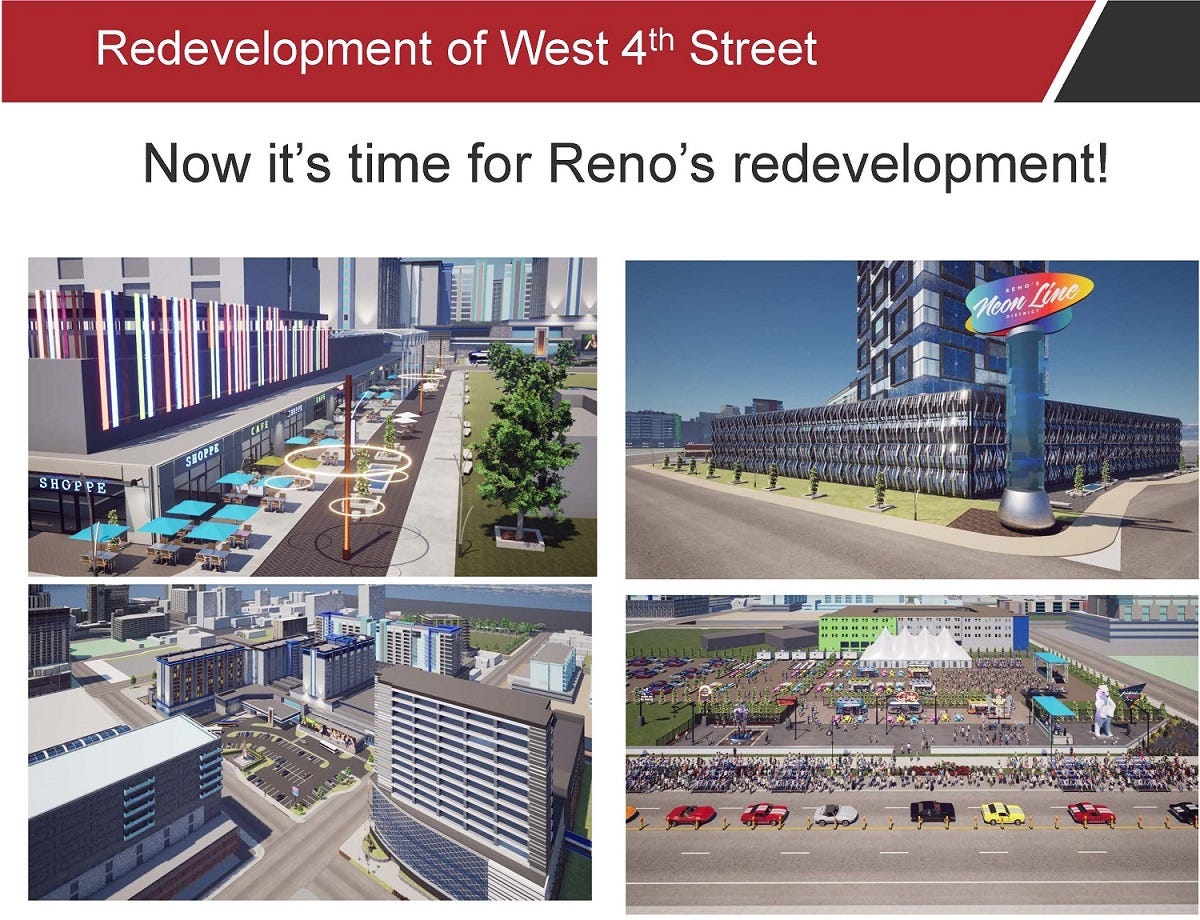
For the actual “Neon Line,” then, what’s the plan? Will Jacobs be crafting a line of entertainment destinations all the way from West to Keystone? Will they build or manage properties subject to specific usage and design constraints?
It doesn’t appear so. When asked that in the meeting, Mr. Gordon explained that the idea is for Jacobs to bring in “other developers, other ideas, and other architectural concepts.” He clarified that Jacobs intends to build and manage very few properties so they can focus on the Sands renovation and entertainment piece, while others can “come in and do a phenomenal job developing out this district.” In fact, Mr. Gordon said, Jacobs is already getting phone calls from people across the country who want to come to Reno and start to build “vertical, market-rate apartments” right away.
That last revelation was interesting for a couple of reasons. First, would these apartments and the other projected 2,000-3,000 housing units be constructed along the “Neon Line,” with its defined brand and distinct aesthetic? Is that a look and feel that is appealing to residential developers—and more importantly, to anticipated tenants?
Second, if Jacobs is already getting calls from developers eager to build, is this an area truly in need of special subsidies intended for spaces not likely to develop without them? Is it possible that the majority of the vacant spaces on and around West 4th Street might eventually be filled by housing and/or retail and/or services such as those already in the vicinity, if left open to any and all comers? And if so, does it make sense to lead with the brand, or to wait and see what’s actually constructed there?
In other words, is it wise to designate and define a district before the district exists?
Although each proposal is unique and deserves independent scrutiny, Reno has of course been here before. Developers and promoters have long pitched City Council with developments that promised to completely transform sections of downtown Reno. Mike Van Houten wrote a terrific piece on his Downtown Makeover site in 2018 (when this area was being called the “Fountain District”) about Reno’s pattern of failed downtown districts. But the pattern of dashed expectations goes back much further.
As I outlined in my book, Reno’s Big Gamble, the City sponsored at least 16 different redevelopment plans for its downtown area between 1983 and 2000 alone, entertaining proposals from OliverMcMillan, the Cordish Company, the White-Leasure Development Company and others, some of which led (directly or indirectly) to a few additions and improvements but never the comprehensive transformation promised.
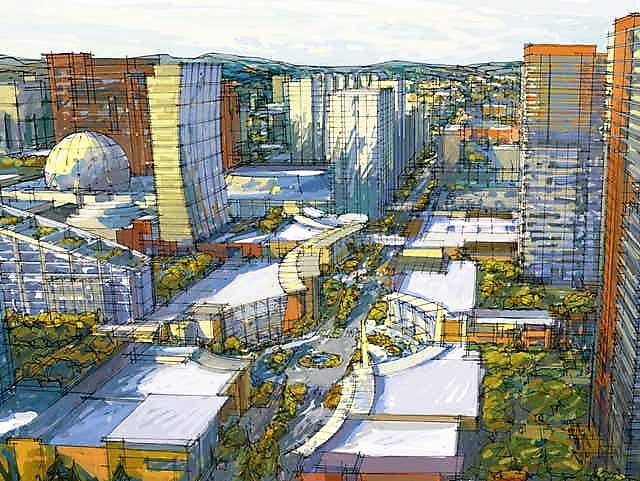
These proposals, like that for the Tessera District (above) have invariably included images of impressive architecture and bustling crowds. But it’s critical to examine what each proposal is actually proposing to build and to what extent and frequency the vitality they depict would result from it. A recent article from Strong Towns offers an excellent guide for analyzing project renderings to determine just that.
Caution and experience dictate a healthy dose of skepticism, particularly when public funds are involved. If anything, history has shown Reno that flexibility is our friend. Unexpected national and world events can be devastating to our tourism and entertainment sectors, whether those threats come in the form of the gradual legalization of gaming across America, sudden economic downturns, or lengthy pandemics. It may not be popular to say it out loud, but Reno knows all too well that there’s nothing much sadder than an “entertainment district” with nobody in it.
Could West 4th Street eventually become a successful “mixed entertainment district”? Possibly. Is that the basket Reno wants to toss more eggs into right now? I’m not so sure. Unless we are meant to consider that label to be warranted by what exists there already—plus the renovations & expansions to the Sands that Jacobs plans to prioritize over the next five years—Reno might want to wait and see what actually transpires there before “fixing” the brand of an area that might evolve in any number of ways.
For better or worse (a deeply complex topic for another day), Jacobs has removed the structures that garnered the most criticism as “blight,” and what remains is a pleasant, centrally-located area that seems well suited for all sorts of potential infill, as you can see in some footage I just shot this morning, driving west from West Street to Keystone Avenue (I may add narration later, but for now, enjoy the jaunty tune!).
Several Councilmembers expressed their desire to hold public workshops to gain community input as the conversation continues (which is basically all they voted to do), and if you have any thoughts, I’d email those to the City Manager, Doug Thornley at thornleyd@reno.gov (copying City Council, if you like).
I’ll return with more updates on various other developments, from the appeals to the building permit issued for the apartments at 700 Riverside Drive (to be heard on May 4th) and the April 28th decision by a City Council majority to reject the appeals to the 314-unit condo project at 6000 Plumas Street (the former Lakeridge Tennis Club site), allowing that project to move forward. It is a busy time for development, my friends, and your participation in these discussions is more important than ever.
As always, you can view my previous issues, with more context, analysis, and tips, on my Substack site, https://thebarberbrief.substack.com/. If you’re not yet one of my 700+ subscribers, click the button below to sign up for free. And have a great week!

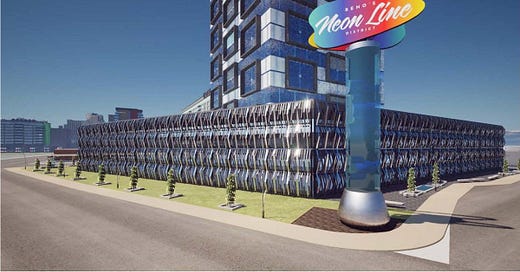


Great article! With the expansion of mixed use zoned areas of Reno and the lack of a noise ordinance, it's time for the city to remember "mixed use" includes full time residential living. It's time for the city to adopt a noise ordinance.
Good article! Appreciated some critical analysis that so far has been missing from the reporting that RGJ and others have done so far.
Wish your book was on kindle! Leaving on a trip tomorrow and wish I could read it